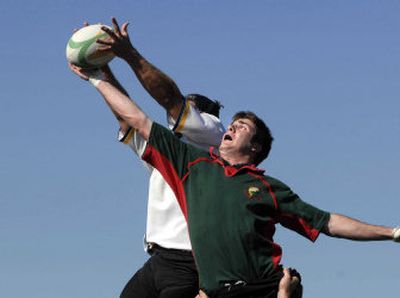Hayden rugby tournament features scrums and chums

It seemed like no hit could bruise the gusto and no loss could dampen the enthusiasm of rugby players from throughout the Northwest at the 2006 Kootenai Cup tournament Saturday in Hayden.
“Rugby is a way of life because it’s just a blast,” said Bruce Murrin, charter member of the North Idaho Men’s Rugby Club. “It’s elegant violence.”
In the last nine years, the club has grown from a few guys who could only find a ball via a Harp beer distributor to about 20 players who host an annual tournament that attracted a dozen teams this year from at least three states and Canada.
They played on three fields outlined with fresh spray paint on the grass and flanked by uprights made of pvc pipe, tape and metal stakes. Players ranged in age from teenagers to a man in his 50s, and varied in size from lithe college women to men who looked like they could probably install a new washing machine by themselves.
“There’s a position for everybody in rugby,” said referee Sean O’Connell.
The game has a few variants, but here it is usually played with 15 people from each team on the field at a time. The goal is to get the ball into the opposite end zone or kick it through the uprights, which can happen at any point during the game.
The action is nonstop, and play doesn’t come to a halt when the ball or player carrying it hits the ground. If tackled, the player has to pass the ball. When players become gridlocked, the teams line up in their entirety to try to push each other to the favorable side while at the same time scrambling to get control of the ball.
Players say it’s an addicting pastime, and interest in rugby in the U.S. has grown substantially in the last decade.
Eventually, O’Connell said he would like to see rugby teams at local high schools.
“It just spreads like wildfire,” he said.
In Southern California, before O’Connell moved to Coeur d’Alene, high school rugby went from two teams in 1998 to about 100 now.
The inclusive nature of the sport and the easygoing culture surrounding it also attract students who might not try out for other sports, he said.
“Rugby’s very big on camaraderie,” said Duane Tompkins, who plays for Eastern Washington University’s Men’s Rugby Club.
Not quite big enough to play college football, the construction management major from Walla Walla said rugby was the solution to his quest for a new contact sport.
“It’s a lot faster. There’s no 30 seconds between plays,” Tompkins said.
He and others also said they believe it’s safer than American football. Blocking for the person with the ball is forbidden. The pads in rugby are minimal, but Tompkins said that makes people a lot more cautious about tackles and other contact.
That’s not to say that nobody gets hurt, though. And like most contact sports, rugby tends to claim its share of shoulder, ankle, knee and other injuries at every tournament.
Rugby players carry their contusions with pride, and all the aggression on the field tends to evaporate once the game is over.
“The same guy you were trying to hurt a minute ago, you are on the sidelines having a beer with and talking about it a minute later,” said Joe Prete, from Butte.
The stocky electrician wears a Mohawk that he’s maintained since his entire team donned the hairstyle for the Missoula All-Maggots yearly rugby festival.
Prete’s favorite part of the North Idaho tournament summed up the sentiment expressed by several players Saturday: “Lots of rugby. Lots of beer.”